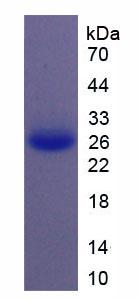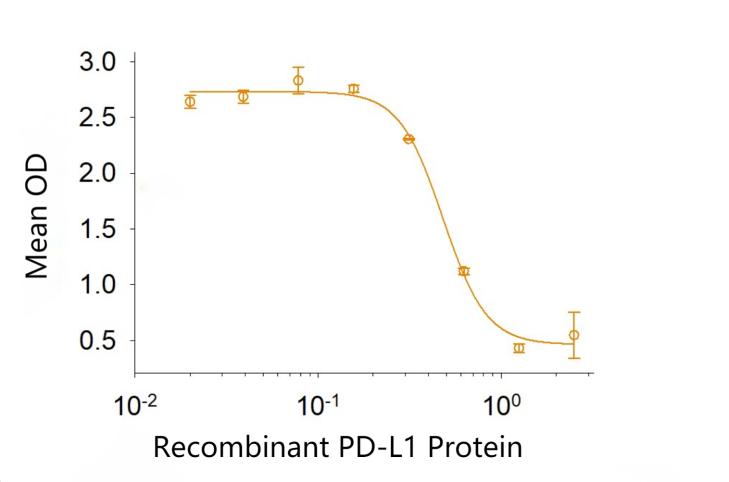
Human Programmed cell death 1 ligand 1 (PD-L1) Protein, Recombinant
产品货号:PR00041HuP1
$ 询价
规格 100ug
浓度 700ug/ml
产品名称:Human Programmed cell death 1 ligand 1 (PD-L1) Protein, Recombinant
状态:Lyophilized
纯度:>95%, by SDS-PAGE under reducing conditions and visualized by silver stain.
内毒素:<0.01 EU per 1 μg of the protein by the LAL method
生物活性:The ED50 for this effect is 0.1-0.6ng/ml
序列起止:Phe19~Arg238
Uniprot链接:Q9NZQ7
宿主:Bacteria
种属:Human
预测分子量:24 kDa
实际分子量:24kDa as determined by SDS-PAGE reducing conditions.
稳定性 & 储存条件:Store for up to one year at -20°C to -80°C as lyophilized powder.Please avoid repeated freeze-thaw cycles.No activity loss was observed after storage at:-20°C to -80°C for 12 months in lyophilized state;-80°C for 3 months under sterile conditions after reconstitution.
复溶:Lyophilized from a 0.2 μm filtered solution in PBS and NaCl.Normally 5 % - 8 % trehalose, mannitol and 0.01% Tween80 are added as protectants before lyophilization. Specific concentrations are included in the hardcopy of COA. Please contact us for any concerns or special requirements.Note:When reconstituting,gently pipet and wash down the sides of the vial .Do not vortex.
质量验证图:
Figure1. SDS-PAGE
For research use only. Not for drug, in vitro, household or other uses.
别称:CD274, PDCD1LG1, B7-H, B7H1, PD-L1
背景信息:PD-L1/B7-H1. B7-H1, also known as PD-L1 and CD274, is an approximately 65 kDa transmembrane glycoprotein in the B7 family of immune regulatory molecules (1). Mature human B7-H1 consists of a 220 amino acid (aa) extracellular domain (ECD) with two immunoglobulin-like domains, a 21 aa transmembrane segment, and a 31 aa cytoplasmic domain (2). Within the ECD, human B7-H1 shares 73% and 74% aa sequence identity with mouse and rat B7-H1, respectively. Alternative splicing generates additional isoforms that either lack the first Ig-like domain or are truncated within the second Ig-like domain (3). B7-H1 is expressed oninflammatory-activated immune cells including macrophages, T cells, and B cells (4-7), keratinocytes (8, 9), enothelial and intestinal epithelial cells (8, 10), as well as a variety of carcinomas and melanoma (11, 12). B7-H1 binds to T cell B7-1/CD80 and PD-1 (7, 8, 12-15). It suppresses T cell activation and proliferation (5, 8, 14, 16) and induces the apoptosis of activated T cells (11). It plays a role in the development of immune tolerance by promoting T cell anergy (7, 14) and enhancing regulatory T cell development (16). B7-H1 favors the development of anti-inflammatory IL-10 and IL-22 producing dendritic cells (5, 10) and inhibits the development of Th17 cells (16). In cancer, B7-H1 provides resistance to T cell mediated lysis, enhances EMT, and enhances the tumorigenic function of Th22 cells (6, 9, 12, 15).
全称:Programmed cell death 1 ligand 1 (CD274)
说明书:待上传


